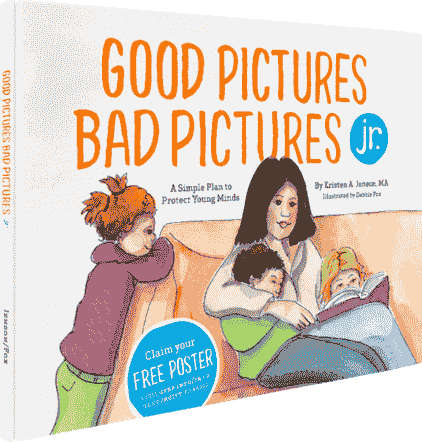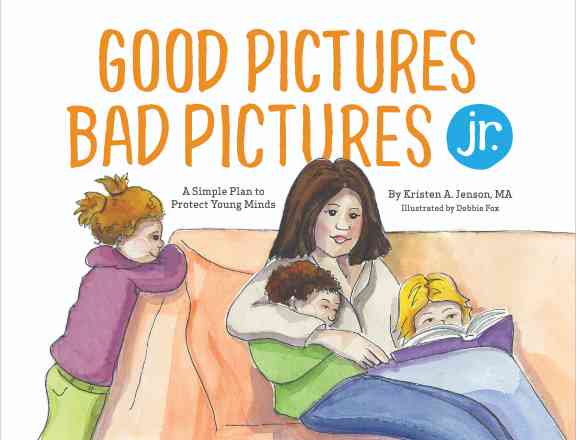

Give Kids Power Over Pornography with 3 Positive Mindsets: Competence, Compassion and Communication
A girl I knew (we’ll call her Maria) was first exposed to pornography when her friend (let’s call her Sunny) pulled up an image on her phone during recess.

“Look what I sent to Brian today,” Sunny said, naming Maria’s older brother. “He hasn’t answered yet, but I bet he’ll see it right after school. Think he’ll text me back?”
Maria’s world seemed to crumble. Here was Sunny, in the middle of a noisy playground, showing off her body to both Maria and Maria’s older brother.
Though her parents had warned her about pornography, she had never actually seen it. She definitely didn’t expect her friend to take a nude photo of herself and share it on purpose!
Sunny seemed proud, excited, and a little nervous. Maria, on the other hand, wanted to cry. To save face, she just nodded without saying a word. Sunny seemed a little disappointed, but quickly joined a game of kickball. With Brian.
Maria was flooded with terror. Was she going to get in trouble for looking? What was Sunny thinking? How would Brian feel? Her stomach jolted as she wondered if Brian got pictures like that all the time. Maybe he even sent them himself. She couldn’t tattle to their mom and dad!
Who could Maria tell, and how? Would Brian be angry if she went to him first? Could she get his phone and delete the picture before he saw it?
It’s a terribly complicated problem for a young person to face.
Unfortunately, Maria’s story is true and far from unique. This young girl was literally sick for a week because of it.
Three skills that help kids deal with disturbing experiences
Children are going to see various forms of pornography whether they seek it out or not. And for them, exposure is far from simple.
The desire to protect others, satisfy curiosity, or to forget about the embarrassing incident can be strong enough to confuse a kid about what to do next. To come through the emotion and paralyzing uncertainty, there are three skills every kid needs to have: competence, self-compassion, and communication.
Competence beats confusion
“I didn’t know what to do.”
How many kids have been confronted with an unexpected situation like this and just didn’t know how to respond?
A plan is the best armor, sword and shield. When kids are prepared with in-the-moment action plans they are capable of protecting themselves from surprise encounters with pornography. Our CAN DO plan is one way to be prepared.
A family’s action plan teaches the child how to protect themselves when a responsible adult is not around to help. Which is most of the time! Competence skills kick right in when the child is overwhelmed, confused, or simply blank. They can shut off the monitor. They can walk away from the TV. They can say, “I don’t want to look at stuff like that.”
Because pornography can cause excitement and interest as well as shock or aversion, even children who’ve been warned can have a hard time responding quickly. A misspelled Internet search, pictures from friends, and TV shows have countless opportunities for accidental exposure. Good training for competence involves thinking ahead and practicing as a family what to do in some of these situations.
You can help your child move from “I didn’t know what to do” to becoming a competent child who can say to themselves, “That is porn and that is not okay.” A capable child can say to a friend, “I don’t want to see any more” and walk away. That’s power!
Related: 5 Ways to Teach Kids to Say NO! to Porn with Assertive Communication Skills
[[CTA]]
Self-compassion stamps out shame
“I’m a bad person.”
That’s the terrible thought that so many kids have when they see pornography. They think that seeing bad images makes them a bad child.
Kids need to understand that pornography is really good at doing what it is intended to do: sell itself by creating powerful cravings to see more. If your child feels that way, it shows that their body is working the way it is supposed to.
After exposure to porn, some kids sink into guilt and shame. It’s confusing that this thing that seems wrong can also leave them wanting more. Because the images will keep coming back - our brains are specifically designed to remember shocking things! And kids may naturally have a desire to seek out more.
All this can lead some kids to repress their healthy sexual feelings and develop shame and anxiety about these natural attractions during growing years. Or even see themselves as weird and abnormal for having these feelings.
If we explain how normal it is to feel both positive and negative feelings, they will understand that they are good, powerful, loving kids who had a normal reaction to viewing sexual content.
Let’s help kids escape the great lie of “I’m a bad person” and replace that with “I’m a good, normal kid who saw some bad stuff.” Kids can place the blame where it belongs - on the pornography. That’s self-respect!
Related: Love Kills Porn! Advice from a Mom Who Cares for One Million Kids
Communication conquers covering up
“I don’t want to talk about it.”
Telling an adult what they’ve experienced can be scary! Kids may feel overwhelming guilt, shame, and confusion. Or they may like it but know that their parents wouldn’t approve. They may not even have the words to explain what they’ve seen, much less what they felt.
And if their parents have never talked about it, kids might think their parents don’t know! What kid wants to be the first one to explain pornography to their mom or dad?
One thing to know - it’s not always crucial to hear the entire story right away. It’s important for the adult to learn exactly what happened. But the urge to hear every detail can wait.
Help your child feel safe and respected in the moment, and then follow up over time. If your child is having a hard time expressing themselves, ask questions with bite-sized answers. For example, “Did you have good feelings, bad feelings, or some of both?” and “How did you feel inside?”
Most importantly, kids need time to get their words out. Learning to express emotions can take years of practice and experience. Mental space, the freedom to think something over or let it go for a while before talking about it, can be really helpful. It can be just the thing they need to calm themselves and figure things out. Be sure to follow up later so they have an opportunity to be heard.
The first follow-up can be as quick as circling back during the same conversation, or as gradual as checking in the next morning. Following up should a process over weeks and even months.
Seeing pornography can be a real upheaval, particularly if it’s the very first time. Some kids may need to get it all out right away. But others need mental space to build their communication skills.
With patience we can help kids get from “I don’t want to talk about it,” to finding comfort and healing by sharing their experience with you. With practice kids can be ready to say, “Hey, something happened, can I talk to you?” That’s great communication!
Related: The 8 Best Questions to Ask When Your Child Has Seen Porn
These three skills--the skills of competence, self-compassion, and communication--are the difference between a child who feels paralyzed and a child who can take action. You can begin developing those skills today by practicing an action plan with your family, praising your child to build their self-esteem, and asking bite-sized questions.
Because warning kids about porn - that’s something. But empowering kids to fight for their own freedom from pornography? That’s everything.



Good Pictures Bad Pictures Jr.
“I highly recommend this book to all people with children. A must have for all parents!” —Amazon Review











